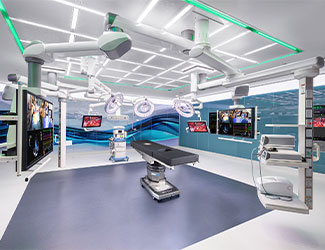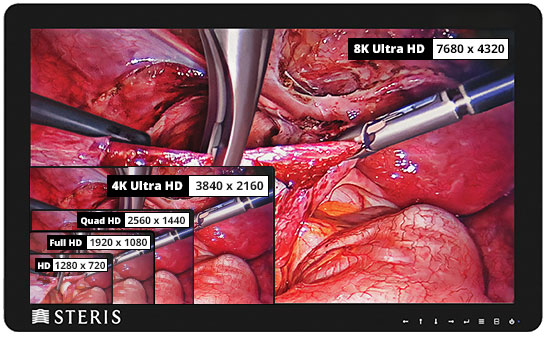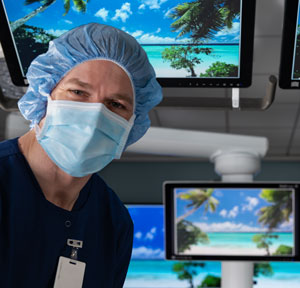Knowledge Center
September 25, 2023
The Evolution of Medical Imaging Displays

Medical displays that provide visualization of surgical procedures are vital to high-quality patient care. Medical display technology is advancing from High Definition to Ultra High Definition (4K). The most common 4K resolution in the medical field is 3840 x 2160 pixels. A surgical display with 4K visualization offers four times the number of pixels and, therefore, four times the detail of traditional High-Definition displays. Additionally, 4K has a wider color spectrum, specifically, a broader spectrum of reds – a beneficial feature in the Operating Room (OR).
In this article, you will learn:
- The best definition for surgical displays
- How surgical displays improve patient outcomes
- The future of visualization in the operating room
What are Surgical Displays?
Surgical displays like 4K Imaging Systems are used to provide instant visualization of intricate patient anatomy during the surgery, displaying a crisp view of the surgical field. A surgical display also provides critical patient information to the surgical staff during a procedure.
Surgical displays with high-definition and 4K visualization provide clear, crisp imagery free of artifacts and no visible pixels. This level of clarity helps surgeons operate with improved visibility of fine detail of the surgical site. They can be mounted to surgical light arms, surgical booms, or walls. The types include diagnostic displays, high-definition and ultra-high-definition displays, and large format displays, 4K and 8K.
What Does Display Resolution Mean?
The display resolution or screen resolution is the number of pixels a screen can show horizontally and vertically. The higher the number, the more pixels displayed, and the clearer your image.
A given display will have a maximum resolution that depends on its physical ability to focus light. The resolution does not refer to the physical size of the display, camera sensor, or image. For example, two displays with the same resolution can have different physical dimensions.
The Evolution of Surgical Displays
Operating Room Displays have followed the technology adoption curve as TVs and computer monitors. CRT (cathode-ray tube) analog monitors created a visible image on a screen by directing three electron beams over millions of phosphor dots to make them light up.
LCD (Liquid Crystal Display) technology uses five layers to bring colors and pictures to life. These layers consist of a backlight, polarized glass, a colored pixel mask, a liquid crystal solution, and a second sheet of polarized glass. The liquid crystals don't create light, though; that job falls to the backlight.
LED stands for light-emitting diode, and these make up the backlights of some TVs. The LEDs either sit behind the screen (full array) or at the edge of the screen (known as edge-lit). The backlight creates the light, which passes through the liquid crystals, along with a few other filter layers, to create the picture.
With four times more pixels and twice the resolution of high definition, 4K captures a greater level of detail, which means that the objects displayed are more defined. The sharper, more detailed image helps improve surgical vision, making it ideal for O.R.s in hospitals, surgical centers, and other medical environments. More pixels give you more detail, increased depth perception, and a broad spectrum of color.
720p - HD Ready
Dimension = 1280 x 720
1080p - Full HD
Dimension = 1920 x 1080
1440p - Quad HD
Dimension = 2560 x 1440
2160p - 4K or Ultra HD
Dimension = 3840 x 2160
or 4096 x 2160
4320 - 8K
Dimension = 7680 x 4320

How Surgical Displays Improve Patient Outcomes In The Operating Room?

Surgical Displays deliver high-definition (HD) and 4K visualization within the surgical field. These surgical monitors easily mount to surgical light arms or to the equipment columns for easy positioning and best viewing to support intricate, visually intensive, and non-invasive procedures. Built for the unique needs of the Operating Room, STERIS's Surgical Monitors offer a slim, lightweight design rated to withstand impact and fluid contamination.
Surgical Displays provide surgeons with better patient visibility
Surgeons experience a wider spectrum of color, with more contrast and a higher level of detail, resulting in increased depth perception.
Surgical Displays support minimally-invasive surgery
Captured with a 4K camera, fine structures can be identified with greater precision, offering surgeons a clearer picture during open surgery or minimally invasive procedures.
Considerations for HD Monitors in the Operating Room
- Medical-Grade Certifications
- Compatibility
- Image Quality & Color Reproduction
- Size & Mounting
- Wide Viewing Angle & Brightness
Browse STERIS Surgical Displays and Large Format Displays
The Future of Visualization in the Operating Room
As the technology in the Operating Room keeps evolving, such as tracking and automation systems, computer-assisted surgery, and remote support. Learn about STERIS ORI Remote Care, the emergence of advanced display technology increases.
The STERIS equipment creates an ecosystem that makes it easy for Customers to be future-ready– the display technologies like the Vividimage® Surgical Display Systems and the Large Format Displays make it easy for the surgical staff to find the data at their fingertips, keeping up with the fast pace, ever-evolving OR systems.
Contributors

Lena Fogle BSN, RN, CNOR
Senior Director Global Clinical Solutions, STERIS Healthcare
![]()
Lena is a seasoned healthcare leader with extensive experience leading complex perioperative environments as well as new program development, continuous process improvement, clinical outcomes, operational excellence, and stakeholder experience.


